Tribology’s Royal Celebration
Dr. Martin Webster | TLT President's Report May 2016
A global community gathered in Buckingham Palace to commemorate the 50th anniversary of the Jost Report—and STLE was there.
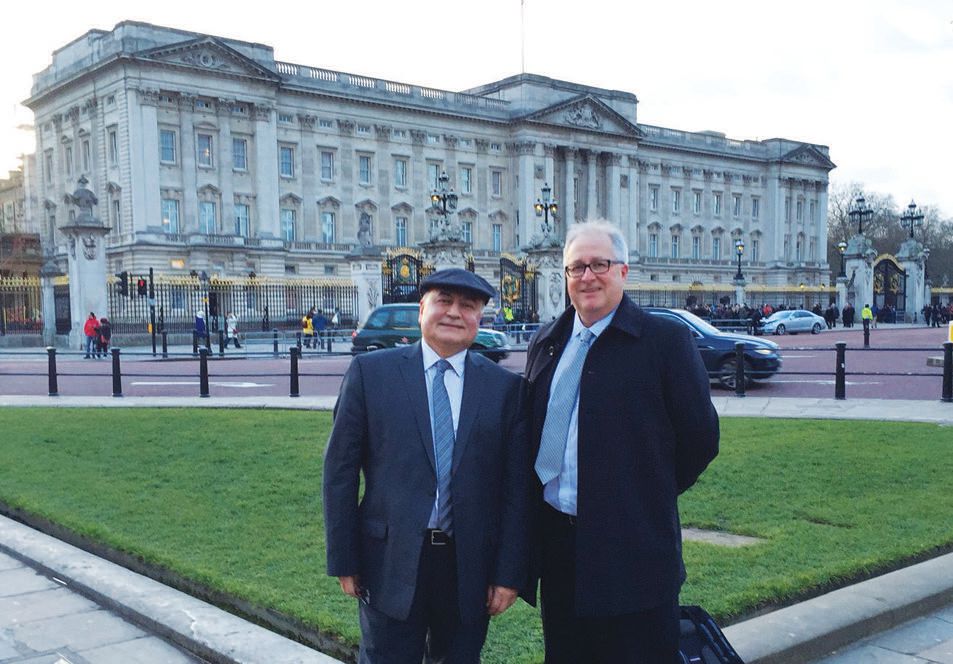
STLE Vice President Ali Erdemir (left) and President Martin Webster just moments before entering Buckingham Palace on March 2 for a party commemorating the 1966 release of the Jost Report.
WHO DOESN'T LOVE A BIRTHDAY OR ANNIVERSARY PARTY? Friends and family can be gathered together, friendships can be renewed and new ones made, generations can be connected and all with the backdrop of sharing a happy occasion or milestone.
Recently, tribology’s worldwide family had an excellent excuse to throw its own party.
On March 9, 1966, a UK government report was published that set in motion events that eventually lead to the formation of a new scientific and engineering discipline. The report highlighted the lack of focus in research and education in subjects associated with friction, lubrication and wear problems and the associated detrimental impact on the UK economy.
In particular, it was estimated that annually more than £500 million (~$725 million at today’s exchange rate) could be saved through better application of the principles controlling friction and wear processes. At the time this represented around 1% of the UK’s GDP. Subsequent studies suggest this is a conservative number when considering both material and energy savings along with the benefits of tackling the world’s energy and environmental issues. In order to tackle the technology challenges in these areas, the report also identified the need for engineers, physicists, chemists and material scientists to collaborate in order to understand the inter-dependence of these individual constituent sciences.
At the time there was no word that described the breadth of the area to help form a community to work on a common purpose. Undeterred, the report committee approached the editor of the Oxford English Dictionary, and the word tribology was born. It is derived from the Greek word
tribos (rubbing) and was given the official definition “the science and technology of interacting surfaces in relative motion and the related subjects and practices.” This heralded the beginning of a new community of researchers and engineers that would work across multidisciplinary boundaries to solve many of the mysteries of what happens in the confined space between moving surfaces.
The committee that conducted the research and authored the report for the UK was chaired by professor H. Peter Jost, CBE, and its report—officially titled Lubrication (Tribology) Education and Research: A Report on the Present Position and Industry’s Needs—has become known simply as the Jost Report. It has had a far-reaching impact. Today almost every industrialized country has institutions that conduct research in tribology, and many industries conduct their own applied research in order to generate next-generation products and services. Worldwide there are more than 40 national societies and groups, including our own STLE, that are dedicated to the area. There is also an International Tribology Council that coordinates the global effort and helps organize the World Tribology Congress that is held in a different country every four years.
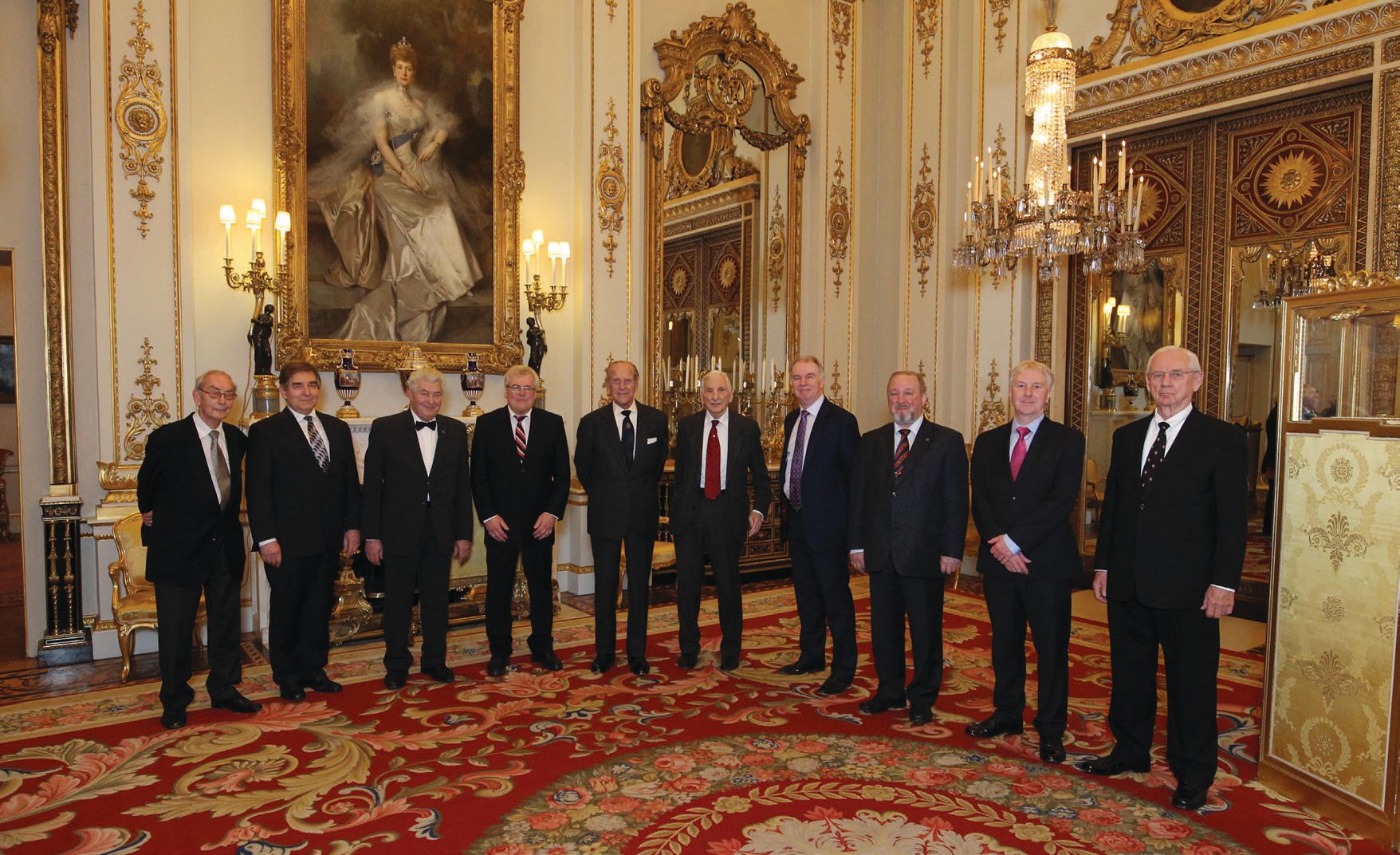 A global gathering (from left): Wilfried Bartz (Germany), Tribology Gold Medalist; Friedrich Franek, president, Austrian Tribology Society; Jean Frêne (France), Tribology Gold Medalist and French Tribology Society; Kenneth Holmberg, chairman-Finnish Tribology Society; H.R.H. The Duke of Edinburgh; Peter H. Jost; Bernie Rickinson, Institute of Materials Mining and Minerals, Nikolai Myshkin, chairman-Society of Tribologists of Belarus; Ian Sherrington, International Tribology Council; Ward Winer (USA) Tribology Gold Medalist.
A global gathering (from left): Wilfried Bartz (Germany), Tribology Gold Medalist; Friedrich Franek, president, Austrian Tribology Society; Jean Frêne (France), Tribology Gold Medalist and French Tribology Society; Kenneth Holmberg, chairman-Finnish Tribology Society; H.R.H. The Duke of Edinburgh; Peter H. Jost; Bernie Rickinson, Institute of Materials Mining and Minerals, Nikolai Myshkin, chairman-Society of Tribologists of Belarus; Ian Sherrington, International Tribology Council; Ward Winer (USA) Tribology Gold Medalist.
It has been 50 years since the Jost Report was published. Two celebratory events have just been held in London. STLE Vice President Ali Erdemir and I were fortunate enough to represent STLE and the North American-based tribology community. Dictated by logistical restrictions, the events were both held on March 2, a week ahead of the actual anniversary.
The first event took place at the headquarters of the Institute of Mechanical Engineers (IMechE). IMechE is an impressive institution that was founded in 1847, and its Tribology Group sponsors the Tribology Trust Bronze, Silver, and Gold medals along with meetings and events. During a pre-event speakers luncheon, I was thrilled to learn that the wooden desk occupying a corner of the room belonged to George Stephenson. For those who may not know, he built the first city-to-city public railway connecting Liverpool and Manchester that was opened in 1830. Stephenson is often referred to as the father of railways, and it was an added bonus to be able to imagine him working at his desk.
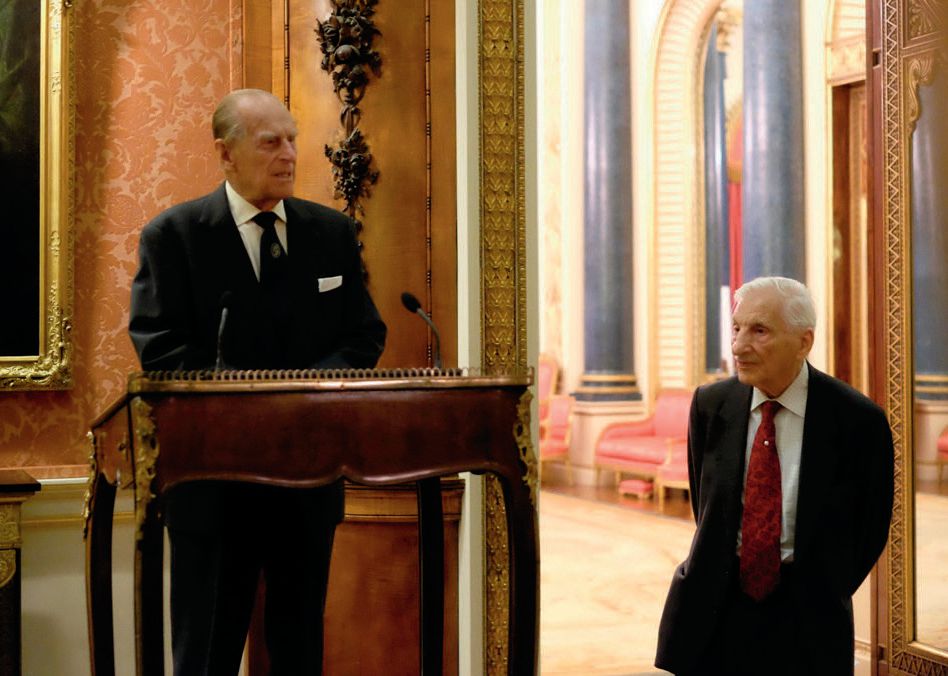 As professor Peter Jost listens, Prince Phillip congratulates an international group of tribologists on their achievements during the past 50 years and spurred them on to even greater triumphs in the future.
As professor Peter Jost listens, Prince Phillip congratulates an international group of tribologists on their achievements during the past 50 years and spurred them on to even greater triumphs in the future.
The IMechE program consisted of lectures from five world-renowned speakers, each of whom reviewed 50 years of progress in their topic area. The topics covered were: liquid lubrication, biotribology, friction and energy saving, measurement and hydrodynamic bearings. Given more time, I suspect that even more themes could have been covered.
Despite this, the program reinforced the idea that we work in a highly diverse and rapidly evolving technology space. It was also a rare opportunity to look back and marvel at how much progress has been made. I was particularly pleased to see a large contingent of graduate students present, and I am sure that they benefited from the combined science and history lesson. Professor Hugh Spikes included a reminder of how much we have come to rely on easy access to automation and computational power these days. He recalled that not so long ago the humble chart recorder and a good notebook were the methods used to record experimental data. His words stirred my own distant memories of postgraduate-level research in which data points were not so easily obtained!
Two members of the original Jost Report committee were present. Professor Peter Jost himself and professor Duncan Dowson from the University of Leeds. Both of these gentlemen remain actively engaged in the tribology community and serve as an incredible example of life-long commitments to their respective fields of interest. Both gave brief accounts of what it was like working on the Jost report and how it has impacted the tribology community.
The event was wrapped up by a series of short speeches. I was honored to present a very brief history of STLE, starting with its formation as the American Society of Lubrication Engineers on March 3, 1944. I highlighted the fact that back in 1987, after much debate, our membership voted to change the name to the STLE. I was proud to say that STLE remains committed to serving those who identify with being tribologists and/or lubrication engineers.
The second event took place during the evening and proved to be even more remarkable. His Royal Highness Prince Philip, the Duke of Edinburgh, hosted a private gathering at Buckingham Palace in central London. Ali Erdemir and I were invited to represent STLE, and we eagerly anticipated the evening as we walked the short distance from the IMechE building to Buckingham Palace. Entering one of the front gates, we crossed the front courtyard upon which the famous changing of the guard ceremony occurs every day. It is a ceremony dating back to the 1600s and is one of the main London tourist attractions. I confess that I felt quite awestruck as we walked toward one of the most photographed entrances in the world.
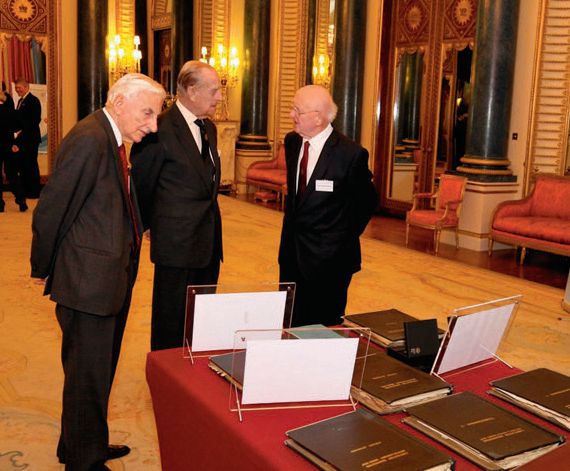 Peter Jost, Prince Phillip and professor Duncan Dowson inspect original versions of the Jost Report.
Peter Jost, Prince Phillip and professor Duncan Dowson inspect original versions of the Jost Report.
After traversing an inner courtyard, we were greeted by Palace staff who took our coats and bags and ushered us to the meeting room. The event took place in the famous Buckingham Palace picture gallery; a room designed by the architect John Nash to show off artwork from the Royal Collection. It took a few moments before I realized that we were surrounded by some of the most famous works by artists such as Titan, Rembrandt and Rubens among many others. In the background, a chamber quartet played, and we were served throughout the evening by the Royal household staff.
The setting was perfect, but equally impressive were the people in attendance. Leaders from the tribology community from all over the world had made the journey to help celebrate the anniversary. In addition to the heads of tribology organizations from Europe and Russia, our friends from China and Japan had made the especially long trip. Ali Erdemir, who is internationally known, was able to introduce me to many guests whom I had not met before. Before long we were circulating around the room catching up with tribological news from across the globe. Also attending were industry leaders and representatives from UK government departments. The atmosphere was very relaxed and promoted informal exchange of news and ideas.
After a while Prince Philip addressed the group. He congratulated the community on reaching the 50th anniversary milestone and noted the significant contribution that the Jost Report had made to science, technology and industry. Professor Peter Jost responded and thanked the Prince for hosting the event. He also reminded us that tribology is critical to life on this planet and that indeed without friction we would never be able to leave the room. I think many of us would have been happy with that, at least for a few extra hours! He also noted that tribology is undergoing a significant expansion as we see a greater emphasis on the new and emerging areas such as biotribology, nanotribology and teratribology. He stressed that we need to continue identifying how improved tribological practices can create economic benefits to industry and society, and it remains critical that we educate the public, industry and governments on tribology’s role in solving many of the global issues facing us today.
After the formal speeches, Prince Philip began circulating around the room to speak to individuals and groups of guests. When my turn came, I informed him that STLE is the society representing the tribology community based in North America. Given my very English accent, he was a little surprised to learn that I represented an institution from across the pond. I was particularly impressed that he circulated long enough to spend a little time with nearly everyone in the room.
In a side room I noticed a small display and an original copy of the Jost Report. Carefully looking through the familiar report I was struck by how forward thinking the report was and that indeed many of its core messages remain relevant today.
All too soon it became time for the event to finish. The time had gone by so quickly, and I would have happily stayed much longer. The event had exceeded my already high expectations, and at a personal level I felt privileged to have been part of it.
As I collected my coat and started to exit the Palace, I reflected that both events really did have everything that a great anniversary party should have. We listened as our father figures recalled the past and reminded us where we came from. We welcomed some newer members into our family. We celebrated a remarkable accomplishment in the form of the Jost Report and honored those who made it happen. We reconnected with friends that we do not get a chance to see very often. And last but not least, we were able to share thoughts on the future directions of our field.
After the event I found myself walking around some of the familiar sites of London. This is something I used to do way back when I was studying there. I reflected on my personal journey and the events that had conspired to lead me to become part of these remarkable events. All those years back, I had no clue that I would be given the opportunity to serve as the STLE president and never dreamt that I would ever attend such a delightful evening at Buckingham Palace.
There is always a bit of an anticlimax once a party is finished. However, we have another big event on the horizon. In May 2020, STLE will celebrate another amazing milestone—its 75th anniversary. Our annual meeting that year is May 3-7 in Chicago, often considered STLE’s birthplace and home. We are already beginning to think of how we will celebrate and make it a week to remember.
Of course you should mark your calendars for all of our forthcoming annual meetings, but place an extra-large mark against May 2020.
Dr. Jost’s response to Prince Phillip’s opening remarks.
During the March 2 celebration of the Jost Report at Buckingham Palace, Prince Phillip congratulated the tribology and lubricant communities for their successes during the past 50 years and wished them even greater successes in the future.
Afterward, Dr. H. Peter Jost, addressed the prince and all attendees. Following are his remarks:
Your Royal Highness – thank you for inviting us to Buckingham Palace to celebrate the 50th anniversary of tribology.
His Royal Highness, having known me for many years, may be tempted not to wholly believe everything springing from my lips, but I can assure him that all of us present are profoundly grateful for Your Highness hosting this event in this marvelous room.
Tribology is not a specialist subject. It is the physical science-based technology of friction. Friction is vital for mankind. Without friction life on earth would not be possible. People could not move, fish could not swim, birds could not fly, nor could airplanes, and without friction it would be impossible to drive a car or a horse-cart. Indeed, without friction it would be impossible for us to leave this room, however much we like the most wonderful paintings.
Tribology has grown into nanotribology, green tribology, biotribology and medical tribology. I hope those engaged in universities and research establishments and others of influence will bridge the gap between their excellent work and the realms of application. We celebrate today in the full knowledge that the outcome of their endeavors will benefit industry and the environment and reduce the use of materials of which there is not an unlimited supply. All these activities lead to the security and the quality of life for this and future generations and help by the application of the ever-increasing knowledge of tribology.
And finally in thanking Your Royal Highness again, I hope Your Royal Highness will enjoy talking to the excellent people here and walking amongst them in the full knowledge that without the friction between his shoes and the carpet, this would not be possible.
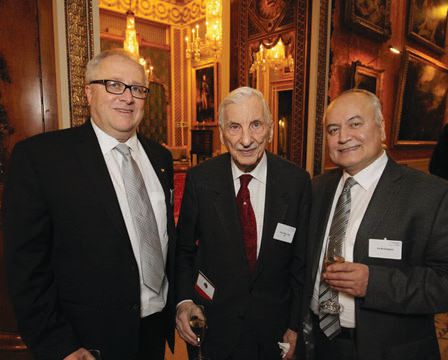 After thanking His Royal Highness, Dr. Peter Jost (center) celebrated the 50th anniversary of the report named after him with STLE President Martin Webster (left) and Vice President Ali Erdemir.
After thanking His Royal Highness, Dr. Peter Jost (center) celebrated the 50th anniversary of the report named after him with STLE President Martin Webster (left) and Vice President Ali Erdemir.
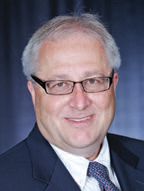 Martin Webster is a senior research associate for ExxonMobil Research and Engineering in Annandale, N.J. You can reach him at martin.n.webster@exxonmobil.com
Martin Webster is a senior research associate for ExxonMobil Research and Engineering in Annandale, N.J. You can reach him at martin.n.webster@exxonmobil.com.